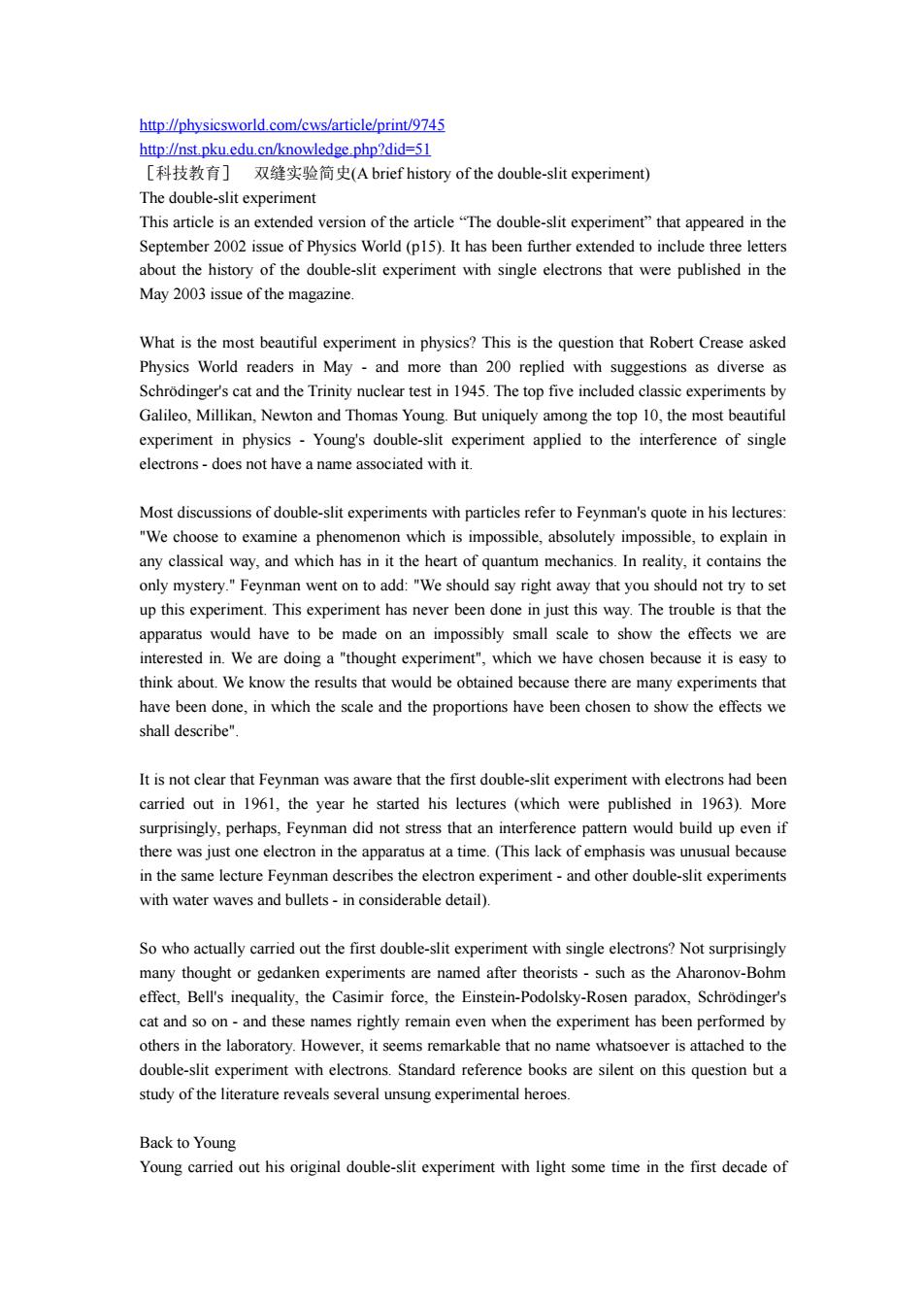正在加载图片...

http://physicsworld.com/cws/article/print/9745 http://nst.pku.edu.cn/knowledge.php?did=51 [科技教育]双缝实验简史(A brief history of the double--slit experiment) The double-slit experiment This article is an extended version of the article "The double-slit experiment"that appeared in the September 2002 issue of Physics World(p15).It has been further extended to include three letters about the history of the double-slit experiment with single electrons that were published in the May 2003 issue of the magazine. What is the most beautiful experiment in physics?This is the question that Robert Crease asked Physics World readers in May -and more than 200 replied with suggestions as diverse as Schrodinger's cat and the Trinity nuclear test in 1945.The top five included classic experiments by Galileo,Millikan,Newton and Thomas Young.But uniquely among the top 10,the most beautiful experiment in physics -Young's double-slit experiment applied to the interference of single electrons-does not have a name associated with it. Most discussions of double-slit experiments with particles refer to Feynman's quote in his lectures: "We choose to examine a phenomenon which is impossible,absolutely impossible,to explain in any classical way,and which has in it the heart of quantum mechanics.In reality,it contains the only mystery."Feynman went on to add:"We should say right away that you should not try to set up this experiment.This experiment has never been done in just this way.The trouble is that the apparatus would have to be made on an impossibly small scale to show the effects we are interested in.We are doing a"thought experiment",which we have chosen because it is easy to think about.We know the results that would be obtained because there are many experiments that have been done,in which the scale and the proportions have been chosen to show the effects we shall describe" It is not clear that Feynman was aware that the first double-slit experiment with electrons had been carried out in 1961,the year he started his lectures (which were published in 1963).More surprisingly,perhaps,Feynman did not stress that an interference pattern would build up even if there was just one electron in the apparatus at a time.(This lack of emphasis was unusual because in the same lecture Feynman describes the electron experiment-and other double-slit experiments with water waves and bullets-in considerable detail). So who actually carried out the first double-slit experiment with single electrons?Not surprisingly many thought or gedanken experiments are named after theorists-such as the Aharonov-Bohm effect,Bell's inequality,the Casimir force,the Einstein-Podolsky-Rosen paradox,Schrodinger's cat and so on-and these names rightly remain even when the experiment has been performed by others in the laboratory.However,it seems remarkable that no name whatsoever is attached to the double-slit experiment with electrons.Standard reference books are silent on this question but a study of the literature reveals several unsung experimental heroes. Back to Young Young carried out his original double-slit experiment with light some time in the first decade ofhttp://physicsworld.com/cws/article/print/9745 http://nst.pku.edu.cn/knowledge.php?did=51 [科技教育] 双缝实验简史(A brief history of the double-slit experiment) The double-slit experiment This article is an extended version of the article “The double-slit experiment” that appeared in the September 2002 issue of Physics World (p15). It has been further extended to include three letters about the history of the double-slit experiment with single electrons that were published in the May 2003 issue of the magazine. What is the most beautiful experiment in physics? This is the question that Robert Crease asked Physics World readers in May - and more than 200 replied with suggestions as diverse as Schrödinger's cat and the Trinity nuclear test in 1945. The top five included classic experiments by Galileo, Millikan, Newton and Thomas Young. But uniquely among the top 10, the most beautiful experiment in physics - Young's double-slit experiment applied to the interference of single electrons - does not have a name associated with it. Most discussions of double-slit experiments with particles refer to Feynman's quote in his lectures: "We choose to examine a phenomenon which is impossible, absolutely impossible, to explain in any classical way, and which has in it the heart of quantum mechanics. In reality, it contains the only mystery." Feynman went on to add: "We should say right away that you should not try to set up this experiment. This experiment has never been done in just this way. The trouble is that the apparatus would have to be made on an impossibly small scale to show the effects we are interested in. We are doing a "thought experiment", which we have chosen because it is easy to think about. We know the results that would be obtained because there are many experiments that have been done, in which the scale and the proportions have been chosen to show the effects we shall describe". It is not clear that Feynman was aware that the first double-slit experiment with electrons had been carried out in 1961, the year he started his lectures (which were published in 1963). More surprisingly, perhaps, Feynman did not stress that an interference pattern would build up even if there was just one electron in the apparatus at a time. (This lack of emphasis was unusual because in the same lecture Feynman describes the electron experiment - and other double-slit experiments with water waves and bullets - in considerable detail). So who actually carried out the first double-slit experiment with single electrons? Not surprisingly many thought or gedanken experiments are named after theorists - such as the Aharonov-Bohm effect, Bell's inequality, the Casimir force, the Einstein-Podolsky-Rosen paradox, Schrödinger's cat and so on - and these names rightly remain even when the experiment has been performed by others in the laboratory. However, it seems remarkable that no name whatsoever is attached to the double-slit experiment with electrons. Standard reference books are silent on this question but a study of the literature reveals several unsung experimental heroes. Back to Young Young carried out his original double-slit experiment with light some time in the first decade of